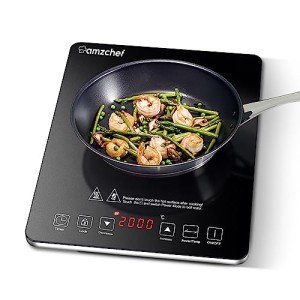The Rise of Sleek Induction Hobs: A Modern Solution for Kitchen Efficiency
In the last few years, the cooking world has actually experienced a significant shift toward more effective and easy to use cooking approaches. A considerable competitor in this evolution is the induction hob, frequently applauded for its sleek style and unrivaled efficiency. This post digs into the functionality, benefits, and factors to consider of induction hobs, gearing up house owners and aiming chefs with the understanding they require to make an informed choice.
What is an Induction Hob?
An induction hob is a type of cooktop that utilizes electro-magnetic energy to generate heat straight in pots and pans. This innovation enables for precise temperature control, quick cooking times, and enhanced security, making induction hobs an appealing function in modern cooking areas.
How Induction Cooking Works
Unlike traditional gas or electrical hobs, which count on heating components to warm the surface area and consequently heat cookware, induction hobs create a magnetic field that engages with ferrous pots and pans (generally steel or cast iron). This interaction produces heat straight in the pot or pan, leading to quicker and more efficient cooking times.
Here's an introduction of the induction cooking procedure:
- Magnetic Field Creation: When the hob is turned on, an electric current passes through coils beneath the surface, producing an electromagnetic field.
- Heat Generation: The magnetic field induces an electric present in the cookware, causing it to heat up.
- Immediate Cooking: Since the heat is produced within the cookware, there is very little heat loss, enabling quick cooking and exact temperature level modifications.
Key Benefits of Induction Hobs
Induction hobs provide a variety of advantages that interest both casual cooks and premium chefs. Below are some of the main benefits of utilizing induction cooking:
- Enhanced Efficiency: Induction hobs are significantly more energy-efficient than their gas and electrical counterparts. Roughly 90% of the energy produced is utilized for cooking, while gas stoves just utilize about 40% of the energy.
- Fast Heating: The induction process warms pots and pans practically instantly, substantially reducing cooking times. For example, water boils much faster on an induction hob compared to conventional stovetops.
- Temperature level Control: Induction hobs provide exact temperature level control, allowing cooks to accomplish the required heat level for various cooking strategies, from searing to simmering.
- Safety Features: The hob surface remains cool to the touch unless cookware is put on it, significantly minimizing the danger of burns. Additionally, lots of induction hobs come with safety features such as automatic shut-off and recurring heat indicators.
- Sleek Aesthetic: The modern design of induction hobs adds a touch of beauty to cooking area areas. Their flat surface areas are easier to clean up and mix perfectly with modern design.
Factors to consider Before Purchasing an Induction Hob
Regardless of their many advantages, there are some considerations to bear in mind when deciding to buy induction hobs:
- Compatible Cookware: Only pots and pans made from magnetic materials works with induction hobs. This includes cast iron, stainless-steel, and certain kinds of enameled cookware. Pots and pans made from glass, ceramic, or aluminum without a magnetic base will not work.
- Higher Initial Cost: Generally, induction hobs can be more expensive in advance compared to gas or electrical hobs. However, this cost can be offset gradually by energy cost savings and increased cooking performance.
- Electricity Dependency: Induction hobs need a reliable electricity source to operate, which could be a disadvantage throughout power outages or in areas with inconsistent electrical supply.
Table: Comparison of Cooking Methods
| Function | Induction Hob | Gas Stove | Electric Hob |
|---|---|---|---|
| Energy Efficiency | High (90%) | Low (40%) | Moderate (70%) |
| Heating Time | Immediate | Moderate | Slower |
| Safety | High | Moderate | Low |
| Surface Temperature | Cool | Hot | Hot |
| Cookware Compatibility | Magnetic-only | All types | Most types |
| Visual Appeal | Sleek and modern | Traditional | Standard |
FAQs About Induction Hobs
1. Can I utilize non-magnetic cookware on an induction hob?No, just pots and pans
that is magnetic will deal with an induction hob. Try to find pots and pans identified as induction-compatible. 2. Do induction hobs take in more electricity?Induction hobs are created for efficiency, taking in less electricity compared to
electrical hobs and gas ranges due to their rapid heating abilities. 3. Are induction hobs safe for children?Yes, induction hobs are considered safer as the surface area stays cool to touch. In addition, safety features can be executed to
lock settings and limit gain access to. 4. How do I clean an induction hob?Cleaning an induction hob is reasonably simple. Utilize Induction Hob Faq or sponge with moderate detergent. Prevent abrasive cleaners that can scratch the surface area. 5. Can I install an induction hob on my
own?While some induction hobs are created for simple installation, it's encouraged to work with a certified professional to guarantee proper setup and electrical connections.
Sleek induction hobs represent a
substantial development in cooking technology, providing unparalleled performance, safety, and aesthetic appeal. As more homes seek to enhance their culinary experiences,
the adoption of induction hobs continues to rise. With their fast cooking times, accurate control, and modern style, induction hobs are not simply a pattern but an important addition to contemporary kitchen areas, catering to the requirements of both expert chefs and home cooks alike. As with any cooking area appliance, it's crucial to weigh the benefits and drawbacks thoroughly to determine if an induction hob is the ideal option for your cooking requires.

